Danish Signaling, Exit Signals
Updated 990405

Contents
Introduction
Exit Signal Types
Exit Signal Aspects and Indications
"Stop" (Danish: "Stop")
"Stop and Proceed"
(Danish: "Stop og Ryk Frem")
"Proceed" (Danish: "Kør")
"Proceed Through"
(Danish: "Kør Igennem")
"Conditional Stop"
(Danish: "Betinget Stop")
Exit Signal Useage
Location of Exit
Signals
Copenhagen
Suburban Lines
Peculiarities

Introduction
Exit signals are found on almost all stations today. Their main purpose
is to mark the exit from the station area and thus act as a sort of "entry
signal" to the line.
Exit Signal Types
Exit Signals may be divided into two physical and two logical types. The
physical types are a 2-lamp and a 3-lamp type as shown below. A variation
of the 2-lamp signal is a 4-lamp signal found on the "S-Bane" (the Copenhagen
Suburban Network) includeing two yellow lamps for a cab signaling aspect.




Logically Exit Signals are divided into advance signaling Exit Signals
and non advance signaling Exit Signals. Non advance signaling Exit Signals
are found where the next Main Signal is preceeded by a Distant Signal.
Non advance signaling Exit Signals are marked by a yellow
plate with a black letter "F" on the mast (left).
Non advance signaling Exit Signals are always the 2-lamp type. Advance
signaling Exit Signals on main lines are always the 3-lamp type. Almost
all double track on the S-bane features the 4-lamp Exit Signal type while
one line features a 2-lamp advance signaling type and yet another features
all three types. Some installations vary from the rule.
Exit Signal Aspects and Indications
"Stop" (Danish: "Stop")
"Stop and Proceed" (Danish: "Stop og Ryk Frem")
| |
 |
 |
 |
-
Stop, then proceed to next Main Signal. Maximum speed in the block after
the Exit Signal is 60 km/h (40 mph). Next Main Signal must be expected
to show "Stop"
|
X |
X |
X |
"Proceed" (Danish: "Kør")
| |
 |
 |
 |
 |
-
Proceed at prescribed speed
|
X |
X |
X |
X |
-
The signal does not convey information about indication on the following
Main Signal
|
X |
|
|
|
-
Expect next Main Signal to show "Stop" (A following Entry Signal may show
"Proceed" or "Proceed Through" with a permitted speed of less than 75 km/h)
|
|
X |
X |
X |
-
Trains with active Cab Signal: Cab signal will govern
|
X |
X |
X |
X |
"Proceed Through" (Danish: "Kør Igennem")
| |
 |
 |
 |
-
Proceed at prescribed speed. Next Main Signal shows "Proceed" or "Proceed
Through" with a permitted speed of at least 75 km/h
|
X |
X |
X |
-
Trains with active Cab Signal: Cab signal will govern
|
X |
X |
X |
"Conditional Stop" (Danish: "Betinget Stop")
(S-bane only)
| |
 |
-
Train without active cab signal: Stop
|
X |
-
Trains with active Cab Signal: Cab Signal will govern
|
X |
Exit Signal Useage
Location of Exit Signals
Exit Signals at Platform Tracks
In the example below, Exit Signals are placed at the end of the platform
tracks. This configuration has gone in and out of use when resignalling
and is therefore primarily found on installations older than the mid-50s
or newer than the mid-80s. This configuration is only used on minor stations
with 2-4 platform tracks, most of them on single track lines. The Exit
Signal acts both as the signal protecting the line and as the signal informing
which train is to depart. The rightmost configuration is an older configuration
(still in use) where the Exit Signals for all tracks are placed together
to form a Signal Group (Danish: Signalbillede).
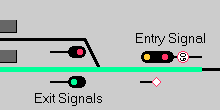
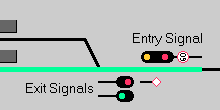
Exit Signals with another Main Signal at Platform Tracks
In the most common application of Exit Signals their main purpose is to
control access to the line outside the station, rather than point out which
train is permitted to leave the station.. The latter task is then carried
out by a signal placed at the end of the platform track, while the Exit
Signal is placed near the Station Limits, usually with the Switch Limit
Board on the same mast.
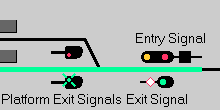
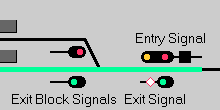
Exit Signal at the Switch Limit combined with Platform
Exit Signals is by far the most common configuration. Where the distance
between Platform Exit Signals and Exit Signal is short, no Proceed aspect
can be shown on the Platform Exit Signal, unless the Exit Signal shows
Proceed. On single track lines this is almost always the case as the low
traffic volume does not justify the extra complexity of the interlocking.
The Exit Signal is controlled by the Line Block System though a release
mechanism keeps it at "Stop" until the station interlocking locks an Exit
Route.
In many such configurations, the Exit Signal can be regarded as superfluous
but a reason for the "extra" signal is to avoid having failed switches
or track circuits in the station area lead to a train having to proceed
onto the line past a signal showing "Stop". It is also likely that the
"extra" signal now and then catches a train having overrun the Platform
Exit Signal and on its way onto a (perhaps) single track line.
Exit Block Signals are sometimes found
instead of Platform Exit Signals on stations with older interlockings.
A common reason is that the station previously had Exit Signals at the
Platform Tracks and no block on the line. When Line Block was added it
was connected to a new Exit Signal and the old Exit Signals were then converted
to Exit Block Signals.
Exit Signals with Exit Route Signals
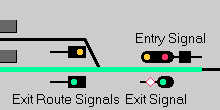
A previously fairly common configuration on larger stations was a common
Exit Signal for all Exit Routes, with individual Exit
Route Signals near the Platform Tracks to indicate which track could
be departed.
Copenhagen Suburban Lines
On the Copenhagen Suburban lines is used a special cab signaling and trainstop
system called HKT (Danish for
"HastighedsKontrol og Togstop" - "Speed Check and Train stop". Using
this cab signaling system, trains do not
use lineside signals, but instead move between HKT Stop Marker signs.
For a description of the Exit Signal when using cab signaling, please refer
to the Platform Exit
Signal and the Automatic
Block Signal documents.
Peculiarities
Sorry, no real peculiarities come to mind...


![]()
























![]()
![]()